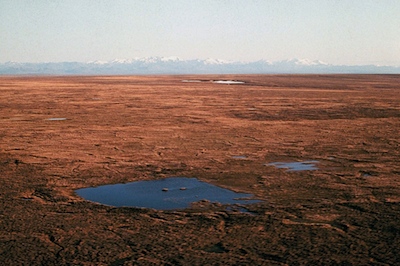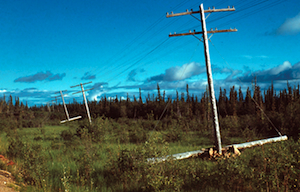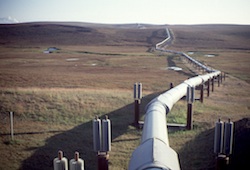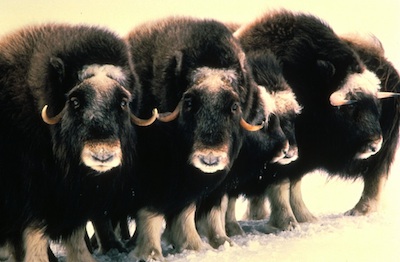The Tundra BiomeThe Arctic TundraWe find the arctic tundra biome at high
latitudes closely associated with the
tundra climate. Notable
areas of arctic tundra are found along the arctic
coastal North America, Europe, Asia and Greenland.
Short grasses, flowers, and grass-like sedges, along
with covers of mosses and lichens are the dominate
forms of vegetation in the tundra. Seasonal frost
heave disrupts root systems preventing support for
tall vegetation. The arctic tundra looks like a
treeless plain, interrupted by patterned ground and an
occasional tree in selected microenvironments. Figure
13.26 View of the Alaskan
Tundra. Pattern ground shown in Figure 13.25 is typical of the tundra landscape. Stone polygons, soil circles, stone or soil stripes and terraces are common to both arctic and alpine tundra. These features are created by thrusting action of repeated freezing and thawing of moist soil over a solid substrate like rock or permanently frozen ground. Polygonal patterns dominate flat surfaces. Vegetation is usually confined to the stable parts of the patterns.
Permafrost
is a common feature of the arctic tundra climate and
biome. Permafrost refers to permanently frozen ground.
Actually, the ground has two layers which freeze. A
surface layer, called the active layer, thaws during
the short "summer" and often subsides. Beneath the
active layer is the inactive layer which stays frozen
throughout the year. Permafrost creates a barrier to
the root development. Larger trees can grow along
better drained river valleys where the depth to
permafrost is greater. The annual freezing and thawing
disrupts root systems inhibiting the growth of very
tall vegetation. Figure 13.28 Trans-Alaska
pipeline snakes across the Alaskan tundra Permafrost creates an engineering nightmare for the construction of buildings and other structures. You can see in Figure 13.26 how telephone poles have been tilted from the heaving of the surface during freezing and thawing. Much concern for damage to the environment was raised over the construction of the Trans-Alaska Pipeline. The heated oil running though the pipeline is insulated from the cold permafrost where it runs underground. In places it zigzags over the surface on stilts that allow it to expand and contract.
The Musk Oxen is a well-known inhabitant of the arctic tundra. A dense fur coat protects them from the severe climatic conditions in the tundra. Beneath is a dense fine undercoat that is fairly waterproof. Adults gather in a protective wall to keep the calves safe from predator attacks and severe storms. Musk oxen inhabited much of Eurasia and North America during the Ice Ages, but now survive only in parts of Greenland and northern Canada. |

 Figure
13.27
Figure
13.27
 Figure 13.29 Musk
Ox of the Alaskan arctic tundra. (Courtesy:
U.S. Fish and Wildlife Service)
Figure 13.29 Musk
Ox of the Alaskan arctic tundra. (Courtesy:
U.S. Fish and Wildlife Service)